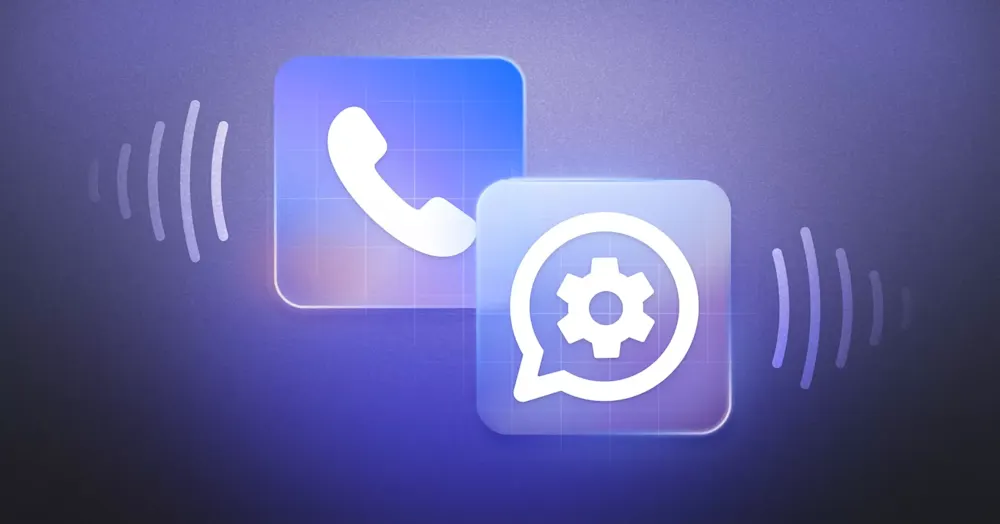
Como atualizar para a API do WhatsApp sem perder a chamada de voz
Saiba como atualizar para a API do WhatsApp sem perder chamadas de voz. Combine mensagens e voz para gerar confiança, resolver problemas complexos e se destacar.
![Comunidades do WhatsApp: um guia prático [dezembro de 2023]](https://assets2-proxy.respond.io/ph8r57dk1q9w/7DPrQT3pGQrYjjbsC1eIoP/68ce6c502b3fd7ba4f2b1298d5fe172a/WhatsAppCommunitiesCoverImage_e2375c6ea1f4a4e129b78615d295c4b4.png?q=70&fm=avif)
Se você abrir o WhatsApp e prestar bastante atenção, poderá perceber que há um novo atalho no canto superior esquerdo. Isso foi adicionado com o lançamento do WhatsApp Communities, uma nova maneira de reunir grupos de usuários do WhatsApp e melhorar a comunicação em larga escala. Neste artigo, ensinaremos tudo sobre Comunidades no WhatsApp: o que são, o que têm a oferecer e, o mais importante, como criar uma Comunidade no WhatsApp.
A maioria dos usuários do Viber já conhece o Comunidades do Viber, um recurso para empresas que buscam se comunicar com seus públicos. Da mesma forma, o WhatsApp começou a lançar as Comunidades do WhatsApp globalmente, gratuitamente, para Android, iOS e desktop.
As comunidades no WhatsApp oferecem aos usuários a capacidade de organizar e reunir grupos do WhatsApp relacionados sob um único guarda-chuva. Os administradores da comunidade podem entrar em contato com os membros com atualizações importantes enviando anúncios, e os membros da comunidade podem permanecer conectados explorando e conversando em grupos que são importantes para eles.
Em outras palavras, é como um supergrupo com espaços dedicados para discutir tópicos específicos.
Cada comunidade no WhatsApp tem uma imagem de perfil, uma descrição e uma lista de grupos dos quais os membros podem participar mediante solicitação.
O WhatsApp Communities é gratuito para todos os usuários do aplicativo pessoal WhatsApp — no momento, ele não está disponível para o aplicativo WhatsApp Business nem para a API do WhatsApp. O WhatsApp afirma que as Comunidades estarão “disponíveis para todos nos próximos meses”, mas a lista de países suportados não foi divulgada.
Na próxima seção, vamos nos aprofundar nos recursos das Comunidades do WhatsApp.
Interessado em criar uma comunidade no WhatsApp? Para começar, você deve saber que existem dois tipos de usuários nas Comunidades do WhatsApp:
Administradores são responsáveis por criar e gerenciar Comunidades, além de terem o poder de moderar todos os grupos da Comunidade
Membros são pessoas que participam da Comunidade do WhatsApp, mas não têm capacidade de gerenciamento
Uma comunidade pode ter até 20 administradores, incluindo o criador da comunidade, e 5.000 membros no total. Os administradores da comunidade podem adicionar até 50 grupos com até 1.024 membros cada.
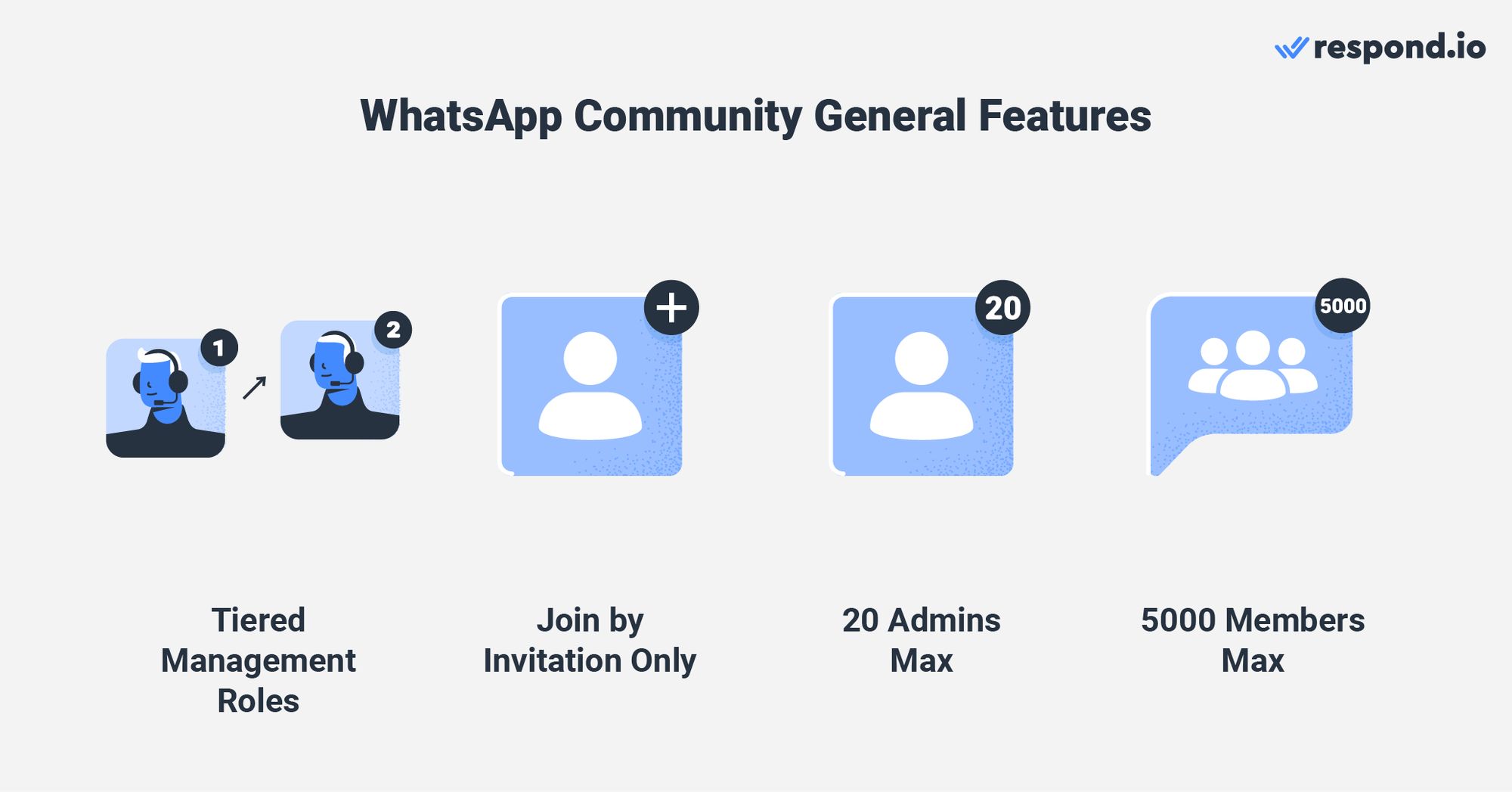
Entrar para uma comunidade não é tão fácil, pois elas não são pesquisáveis. A única maneira de participar é por meio de um convite de administrador. Tanto administradores quanto membros podem sair das comunidades silenciosamente a qualquer momento, pois as saídas não serão anunciadas em nenhum grupo.
Por fim, o WhatsApp tem sido muito aberto sobre a privacidade das Comunidades do WhatsApp, seguindo sua política de criptografia de ponta a ponta. As Comunidades do WhatsApp também contam com alguns recursos interessantes de mensagens, que explicaremos a seguir.
Por padrão, cada comunidade do WhatsApp tem um grupo de anúncios com capacidade para 5.000 participantes. O grupo de anúncios é fixado no topo do menu Comunidade e é identificado pelo ícone de alto-falante.
Todos os indivíduos da Comunidade estarão neste grupo, onde os administradores podem transmitir anúncios e outras mensagens relevantes para todos os membros da comunidade. Os membros não podem bater papo no grupo de anúncios; eles só podem ler mensagens enviadas pelos administradores.
Os usuários são adicionados automaticamente ao grupo de anúncios quando ingressam em uma Comunidade do WhatsApp. Uma vez dentro, eles podem solicitar acesso a qualquer um dos grupos listados para conversar com outras pessoas. Usuários que abandonarem o grupo de anúncios sairão da Comunidade.
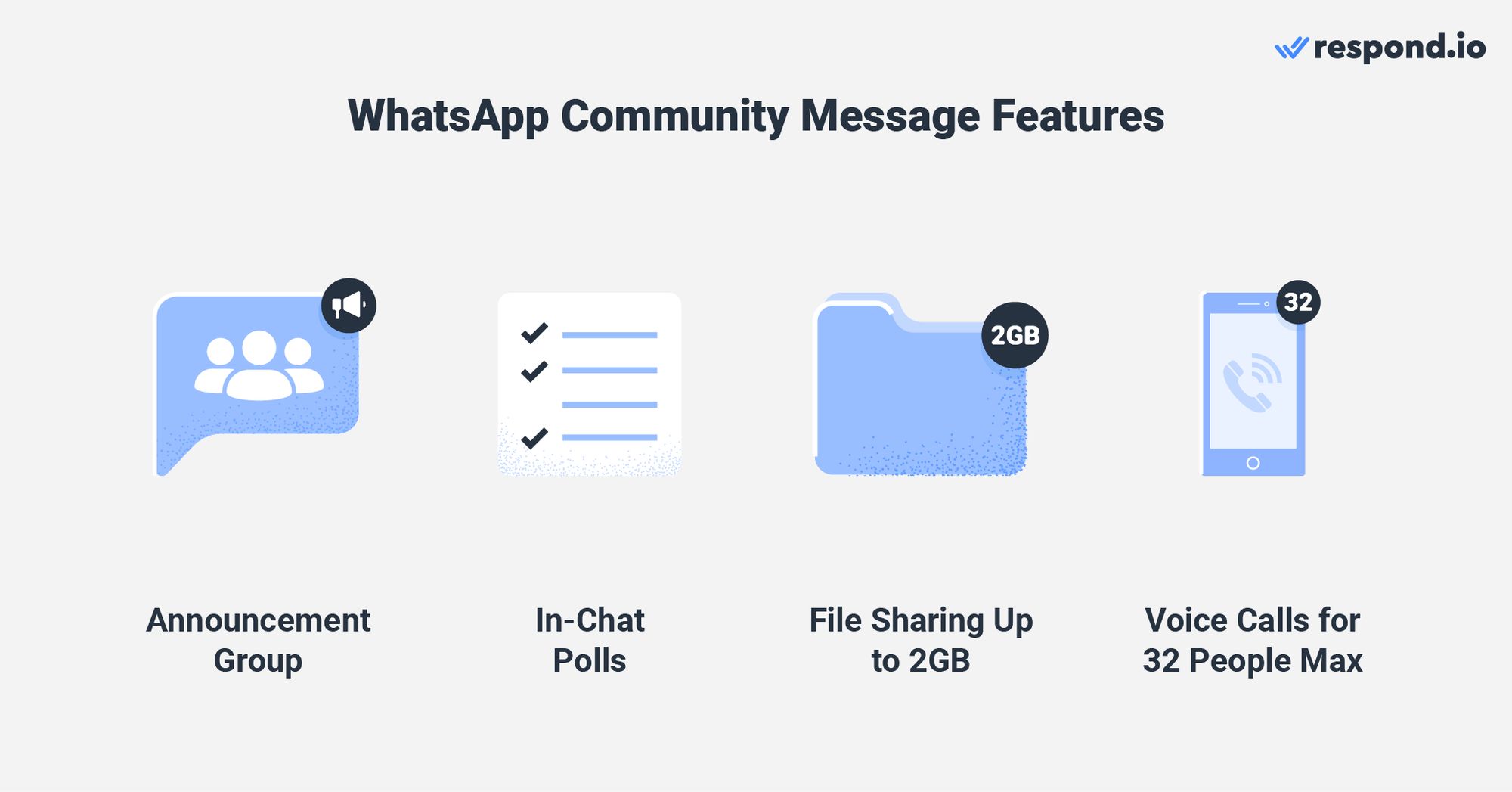
O WhatsApp também lançou alguns recursos de mensagens para aproveitar ao máximo o lançamento das Comunidades do WhatsApp.
Reações de emojis para permitir respostas expressivas e evitar encher o chat com mensagens
Enquetes no chat para obter opiniões em tempo real em grupos individuais do WhatsApp
Compartilhamento de arquivos até 2 gigabytes por arquivo para todos os grupos, incluindo o grupo de anúncios
As funcionalidades de mensagens são importantes, mas a moderação da comunidade também. Vamos ver quais recursos de moderação o WhatsApp Communities oferece.
Os administradores têm controle total sobre suas comunidades do WhatsApp, pois são responsáveis por mantê-las livres de conteúdo prejudicial, spam e mau comportamento. Aqui estão algumas coisas que eles podem fazer:
Gerenciar informações da comunidade, como nome, descrição e foto do perfil da comunidade
Crie novos grupos, adicione grupos pré-existentes ou remova-os da Comunidade. Observe que todos os membros do grupo se tornarão membros da comunidade quando um grupo existente for adicionado.
Denunciar e remover membros abusivos de grupos ou da Comunidade
Tornar membros administradores em uma Comunidade
Rebaixar administradores para o status de membro se eles não estiverem jogando de acordo com as regras da comunidade
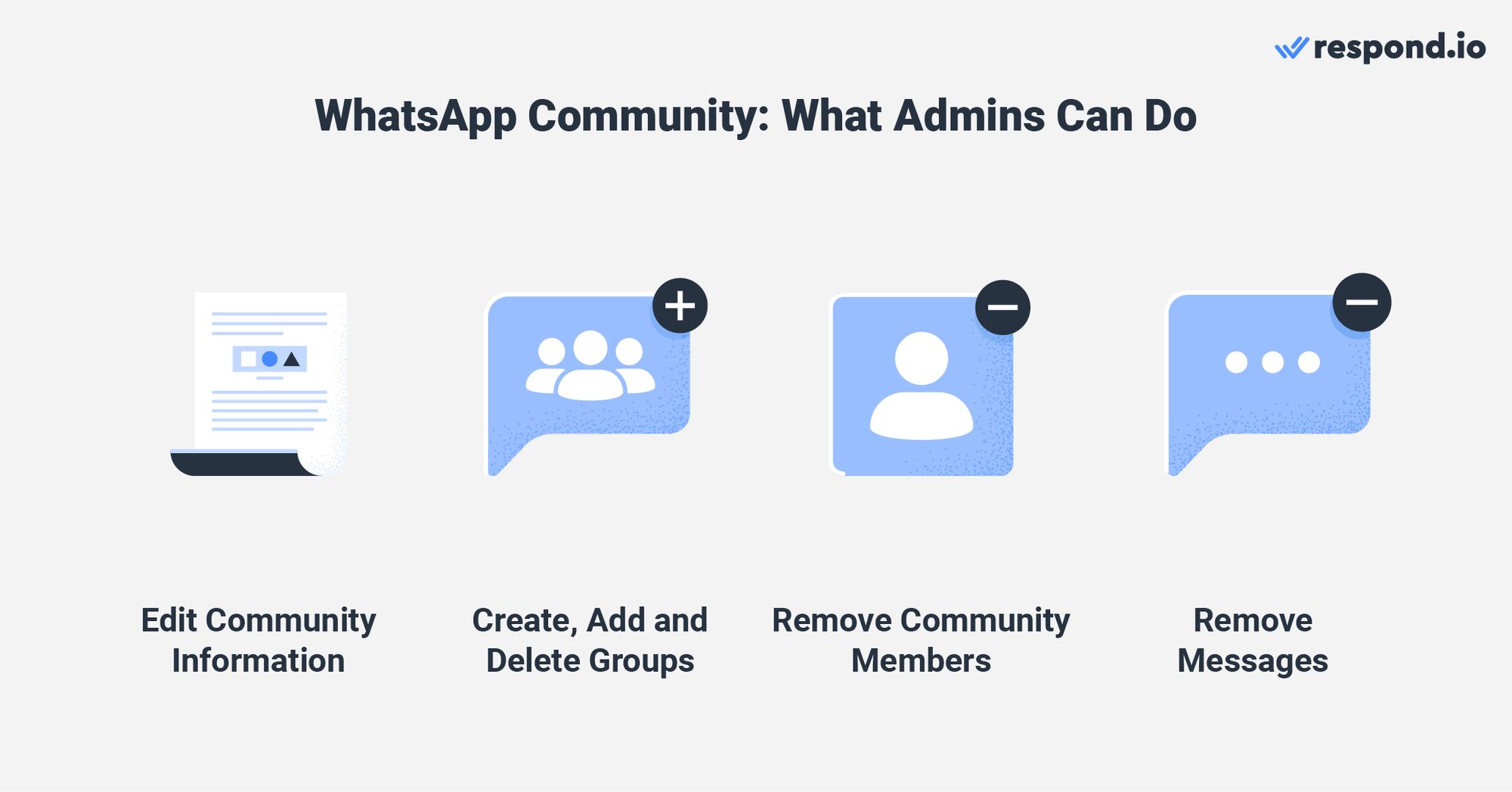
Os administradores da comunidade poderão remover mensagens individuais abusivas, de spam ou fora do tópico de qualquer bate-papo em grupo, a seu próprio critério. Os criadores de comunidades não podem ser removidos de uma Comunidade e apenas eles podem desativar uma Comunidade inteira.
Até agora, apresentamos as Comunidades do WhatsApp e analisamos seus recursos. Agora você deve estar se perguntando “quão úteis são as Comunidades para empresas?”
Transforme conversas em clientes com a API oficial do WhatsApp da respond.io. ✨
Gerencie chamadas e chats do WhatsApp em um só lugar!
Se você visitou o Centro de Aprendizagem das Comunidades do WhatsApp, provavelmente notará que elas foram projetadas com alguns setores em mente (educação, grupos de voluntários e saúde, entre outros).
Como as Comunidades não são pesquisáveis dentro do aplicativo e as admissões são apenas por convite, não podem ser usadas para aumentar a visibilidade dos negócios. Se isso for importante para você, considere experimentar as Comunidades do Viber se seus clientes também estiverem no Viber.
No entanto, uma comunidade do WhatsApp ainda pode trazer alguns benefícios para o seu negócio, especialmente quando se trata de marketing do WhatsApp. Nesta seção, discutiremos como esse recurso aumenta o envolvimento do público, dá suporte aos clientes e cria uma comunidade em torno da sua marca.
O novo recurso Enquetes está disponível para grupos do WhatsApp e, claro, grupos em uma Comunidade do WhatsApp. Ela oferece às empresas uma maneira de obter insights sobre as preferências do seu público.
Por exemplo, uma empresa de alimentos e bebidas pode usar enquetes do WhatsApp para perguntar a um grupo de clientes sobre seu sabor de refrigerante favorito. Da mesma forma, um organizador de eventos pode usar enquetes do WhatsApp para estimar quantas pessoas participarão de uma festa privada.
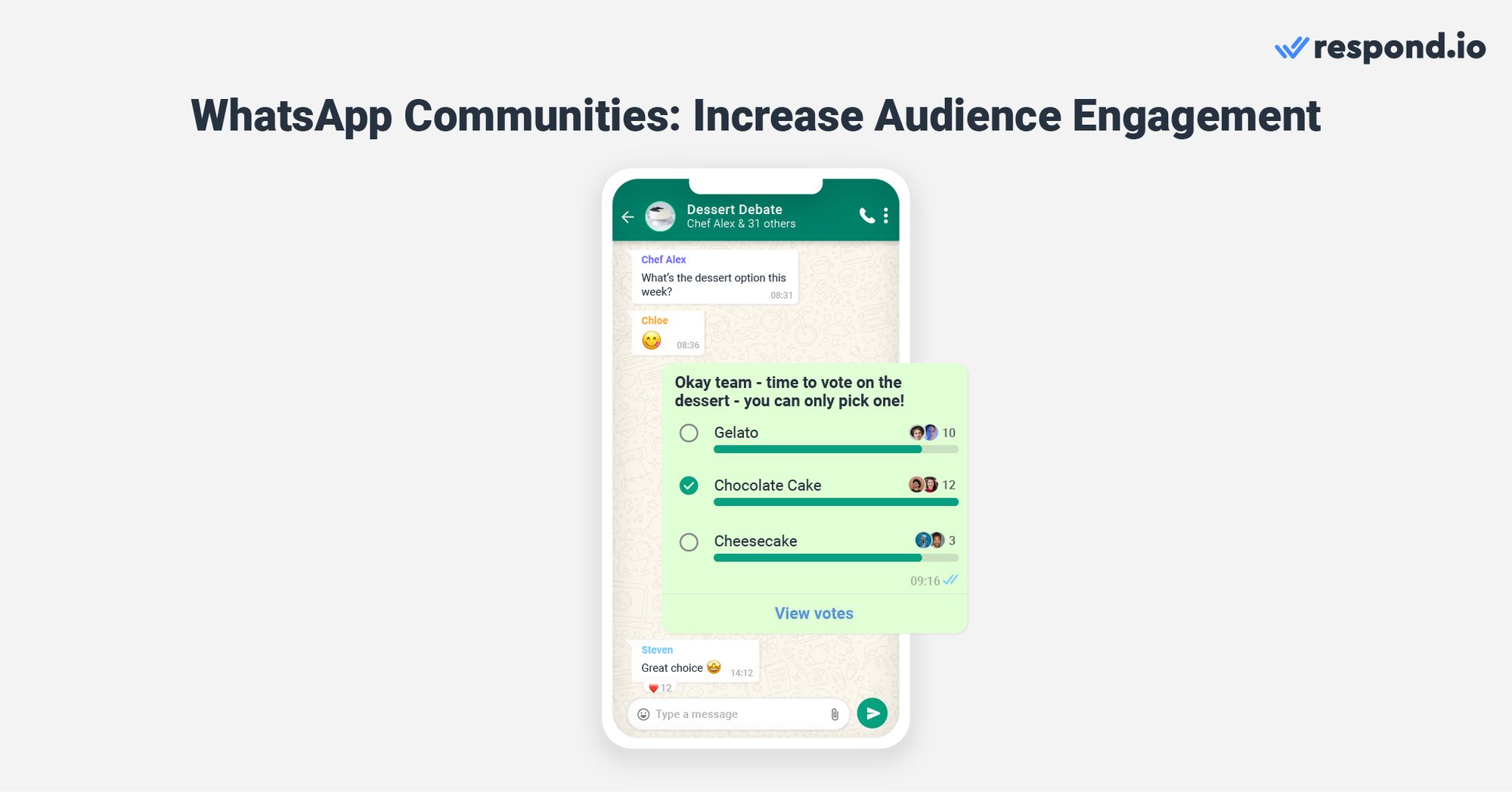
Os resultados da enquete podem ser acessados pelos administradores da comunidade e pelos membros do grupo por meio do botão Ver votos abaixo da enquete. É uma solução vantajosa para todos: os clientes adoram empresas que se comunicam abertamente e as empresas têm acesso gratuito ao feedback dos clientes.
As Comunidades do WhatsApp apresentam oportunidades para marcas boutique que têm segmentos de público exclusivos ou VIP. As marcas podem enviar links de convite para clientes com o perfil certo para elas.
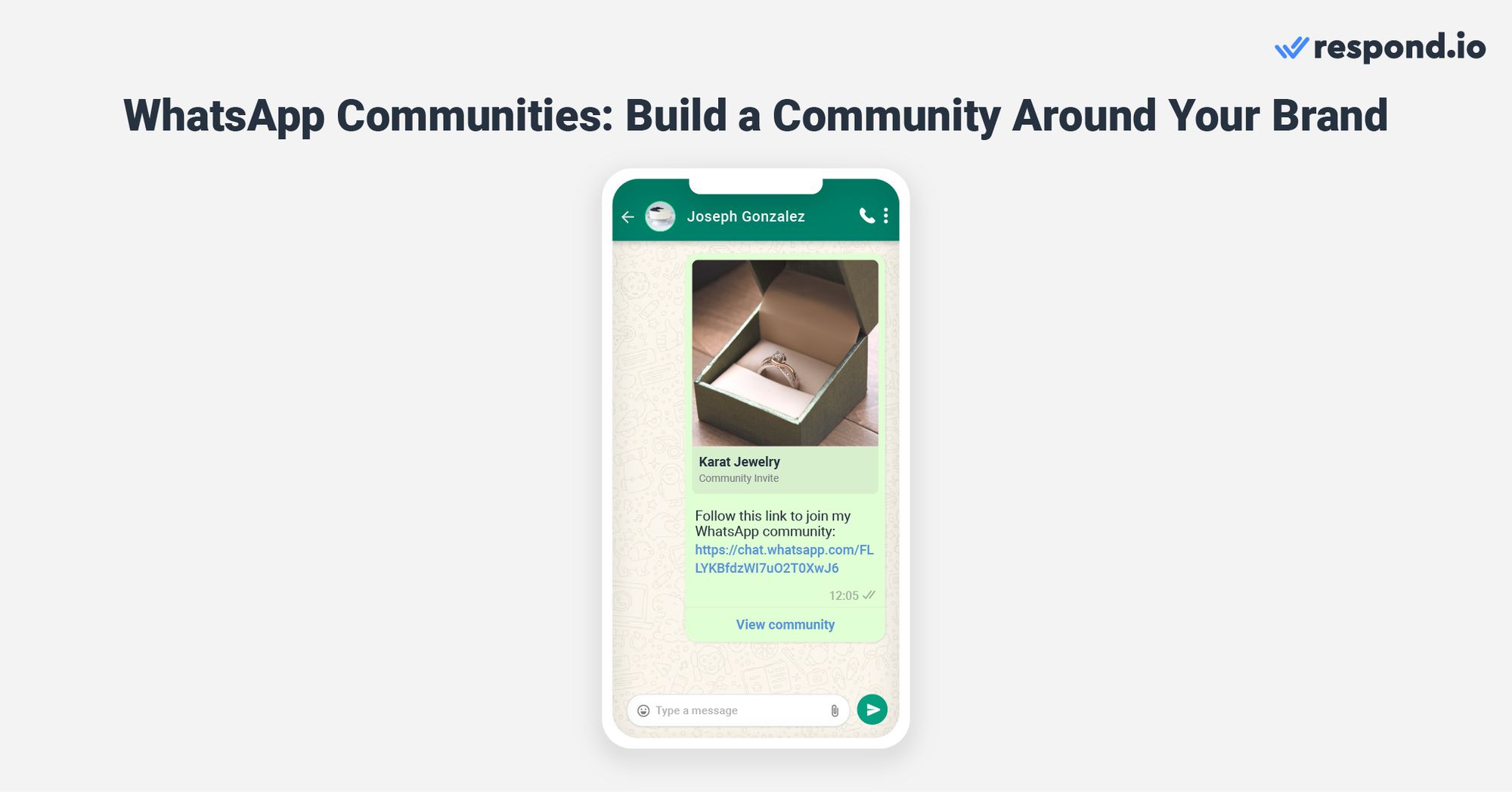
Fazer parte de uma comunidade unida com acesso privado a informações ou eventos selecionados dá aos membros exclusividade, aumentando potencialmente sua fidelidade à marca.
As empresas que se comunicam em grande escala pelo WhatsApp agora têm mais facilidade para manter todos na mesma página. Com o grupo de anúncios, todos os anúncios vêm de uma única voz, diminuindo as chances de falhas de comunicação.
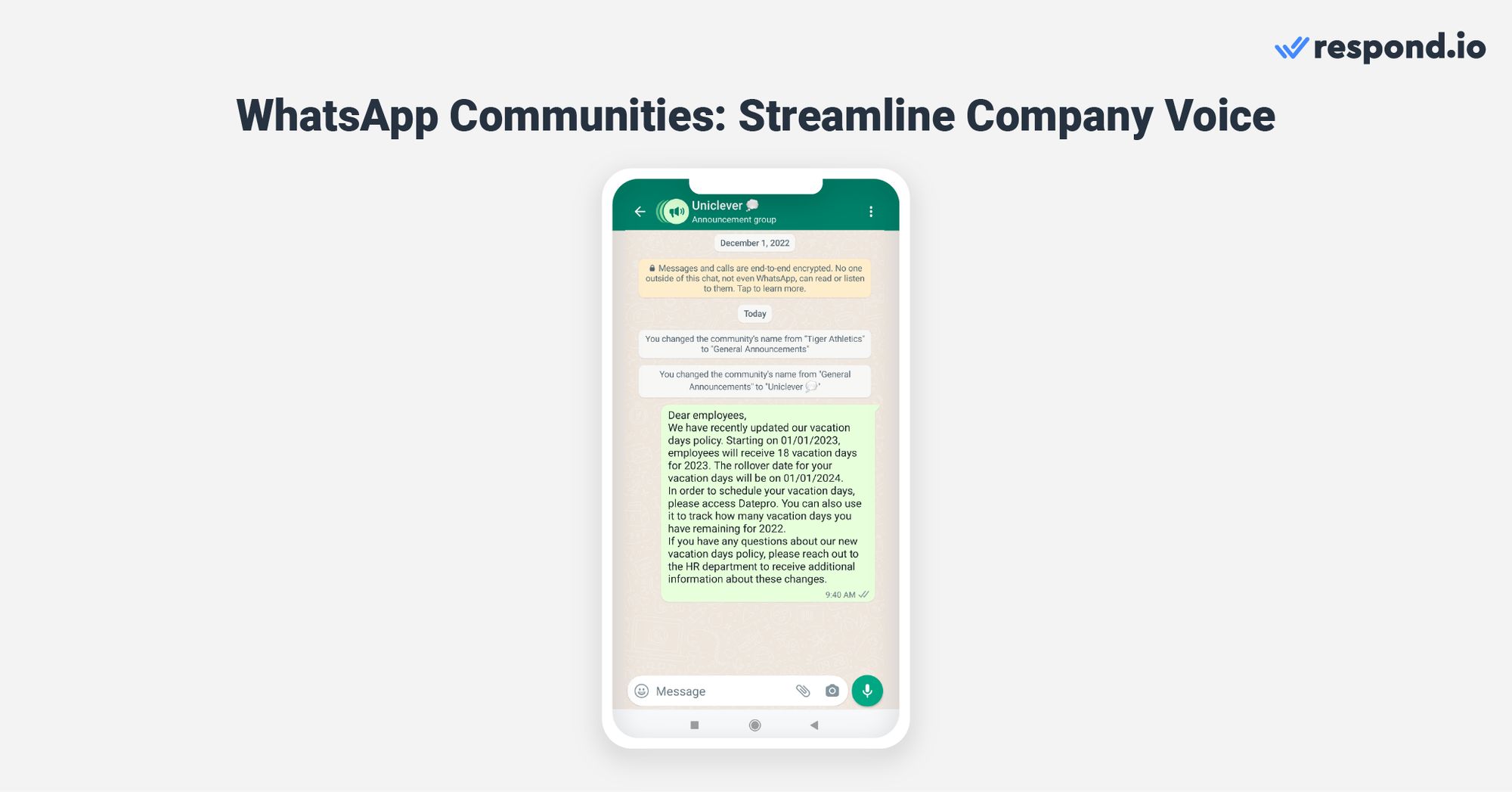
Seja conversando com clientes ou funcionários em sua Comunidade, todos ficam atualizados com as mesmas informações. Na próxima seção, mostraremos os passos para criar uma Comunidade do WhatsApp.
Se as Comunidades do WhatsApp já estiverem disponíveis no seu país, você terá a opção de criar uma no aplicativo WhatsApp no seu telefone ou desktop. Para criar uma Comunidade do WhatsApp, abra o WhatsApp no dispositivo de sua escolha e siga estes passos:
1. Navegue até a aba Comunidade e pressioneNova Comunidade.
2. Digite o nome da comunidade, a descrição e a foto do perfil. Toque na seta verde quando terminar.
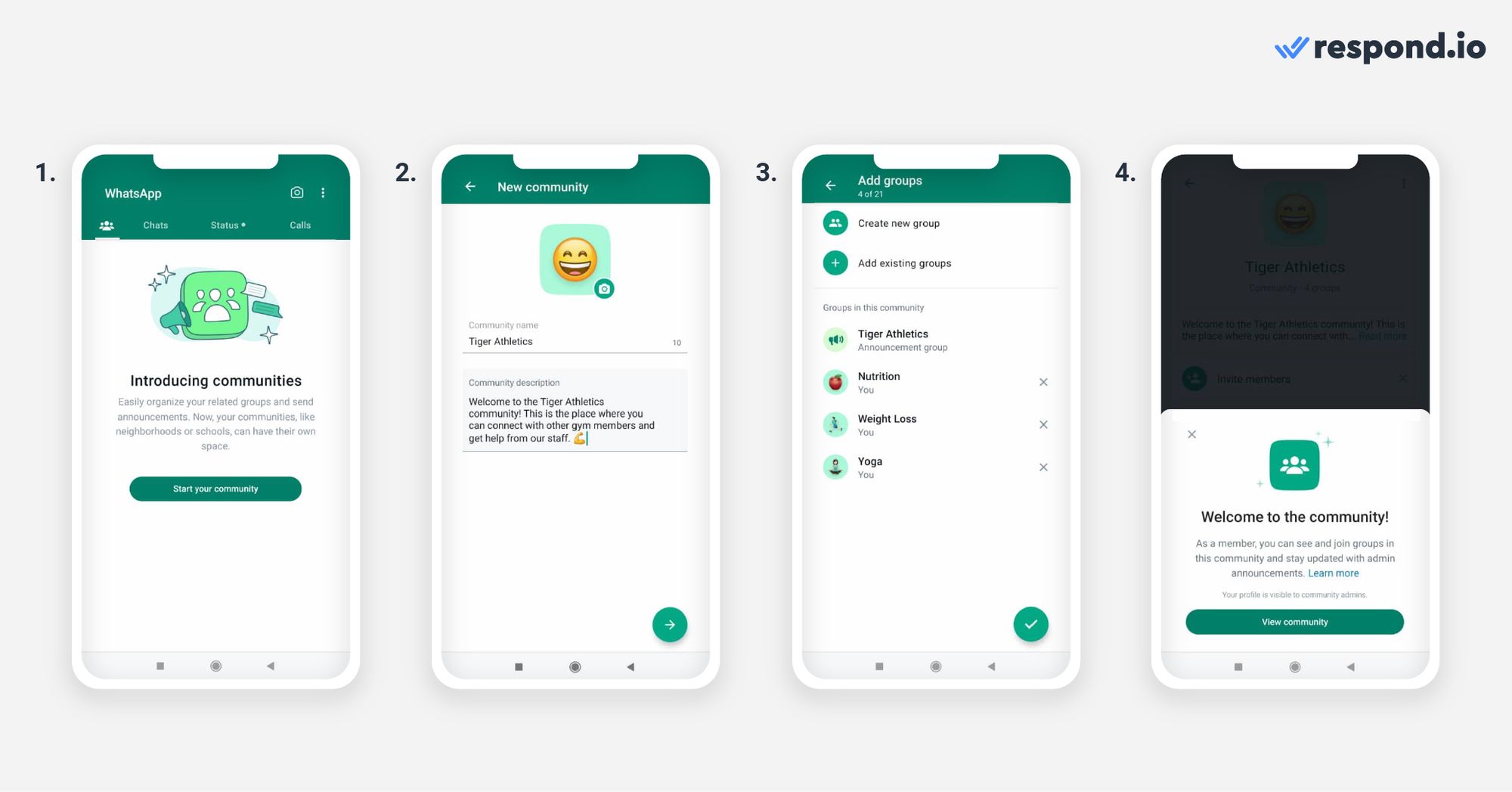
3. Toque em Criar novo grupoouAdicionar grupos existentes.
Se você selecionou Criar novo grupo, adicione um ícone de grupo, uma breve descrição e o assunto do grupo, que é o nome do grupo que todos os participantes verão.
Se você selecionou Adicionar grupos existentes, selecione quais grupos adicionar e toque no ícone de seta verde. Tenha em mente que todos os grupos existentes que você adicionar manterão seus administradores de grupo originais, mas eles não se tornarão administradores da Comunidade a menos que você os promova.
4. Toque em no ícone de marca de seleção verde quando terminar e depois em Ver Comunidade.
E pronto! O próximo passo é aumentar sua comunidade do WhatsApp enviando um convite aos seus clientes ou colaboradores. Vamos ver como isso é feito.
Como mencionado, um administrador deve compartilhar um link de convite para trazer membros para uma Comunidade do WhatsApp. Novamente, isso é possível pelo aplicativo WhatsApp no seu telefone ou desktop:
1. Abra Comunidades do WhatsApp e clique no nome da comunidade.
2. SelecioneConvidar membros se estiver fazendo isso de um telefone. Para usuários de desktop, selecione Ver membros e depois Convidar para a comunidade por link.
3. Escolha como você gostaria de compartilhar o link de convite da Comunidade entre as opções disponíveis.
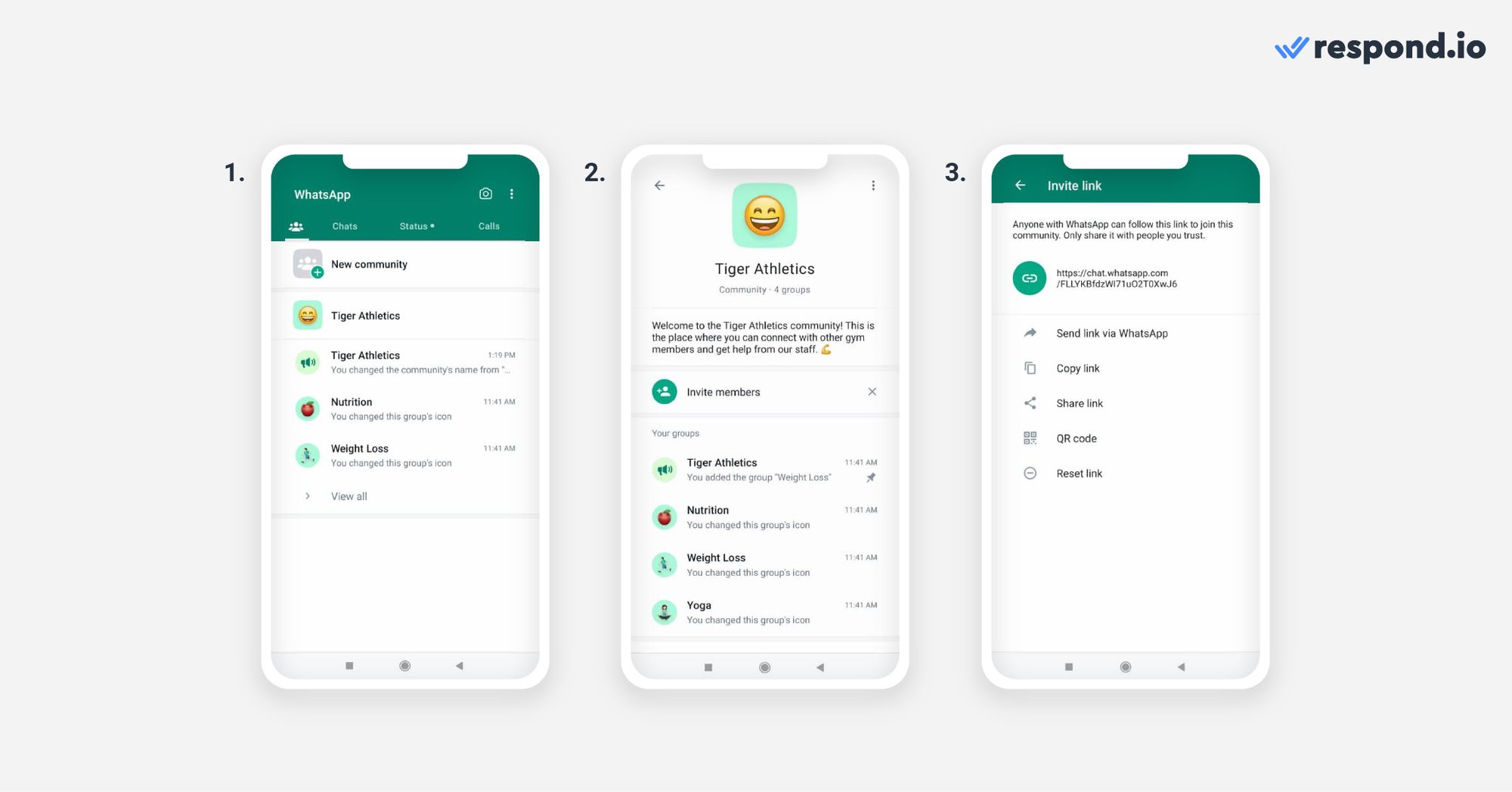
Agora, você está pronto para criar sua própria Comunidade e adicionar membros para fazê-la crescer. Mas talvez você não tenha certeza de como usá-los em seu caso de uso. Não se preocupe; compartilharemos algumas ideias na seção a seguir.
Como esse recurso é bastante novo e foi projetado originalmente para colaboração entre organizações da Comunidade, não há um longo histórico de empresas usando Comunidades do WhatsApp para negócios.
De qualquer forma, encontramos alguns aplicativos interessantes que atendem à maioria das empresas que usam o WhatsApp para fins de marketing e comunicação interna.
Como mencionado, os grupos de anúncios têm uma enorme capacidade de membros e somente administradores podem enviar mensagens. Elas podem ser uma boa maneira de compartilhar atualizações e promoções sem custos!
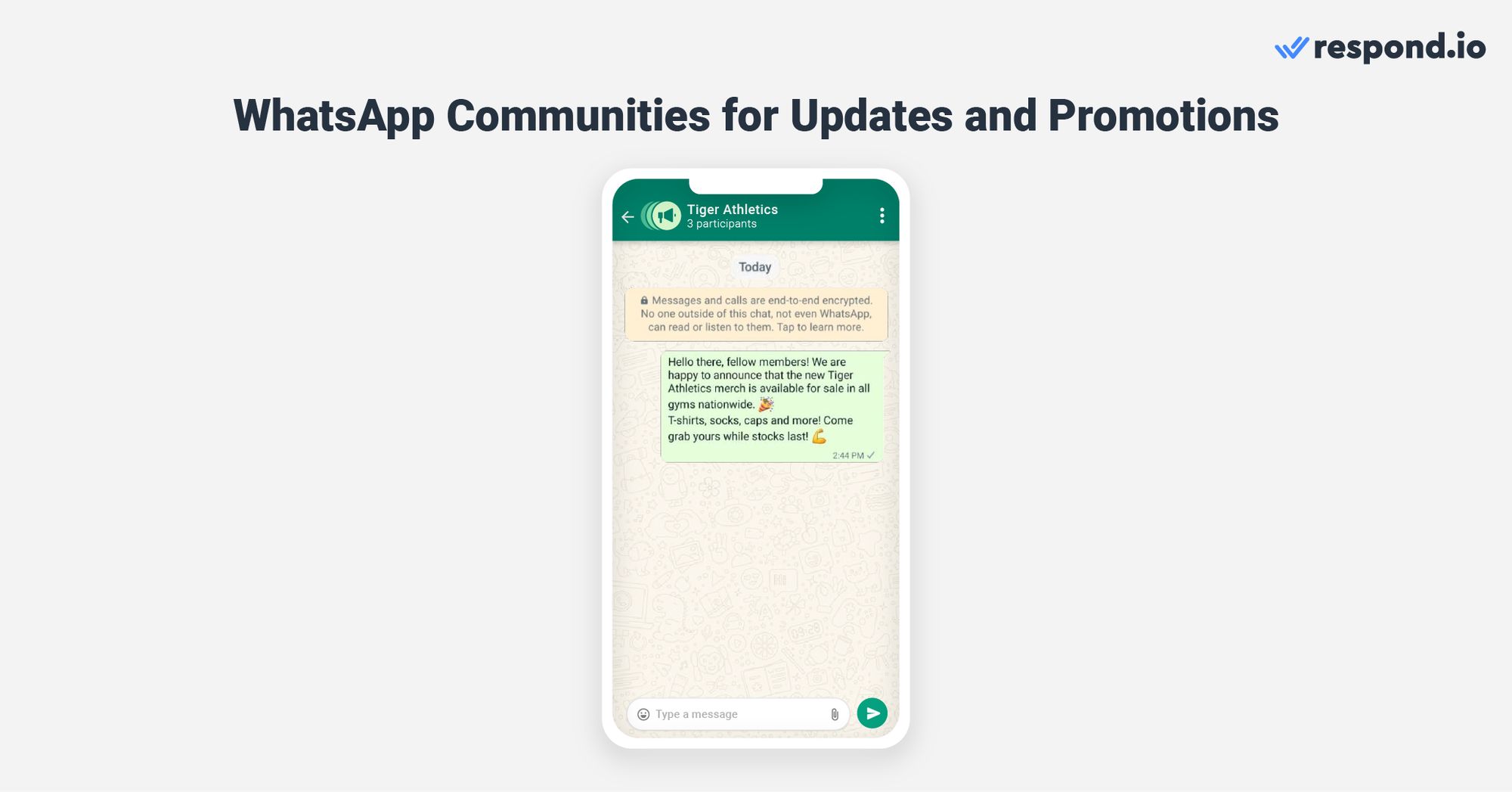
Pequenas empresas que costumavam alternar entre diferentes grupos do WhatsApp para diferentes segmentos de clientes agora podem reuni-los em uma única Comunidade para uma comunicação mais organizada com os clientes e cooperação administrativa.
Com as Comunidades do WhatsApp, os membros sempre têm acesso à assistência necessária em conversas em grupo. Essa ajuda seria fornecida não apenas pelos administradores da comunidade, mas também por outros membros com experiência no assunto.
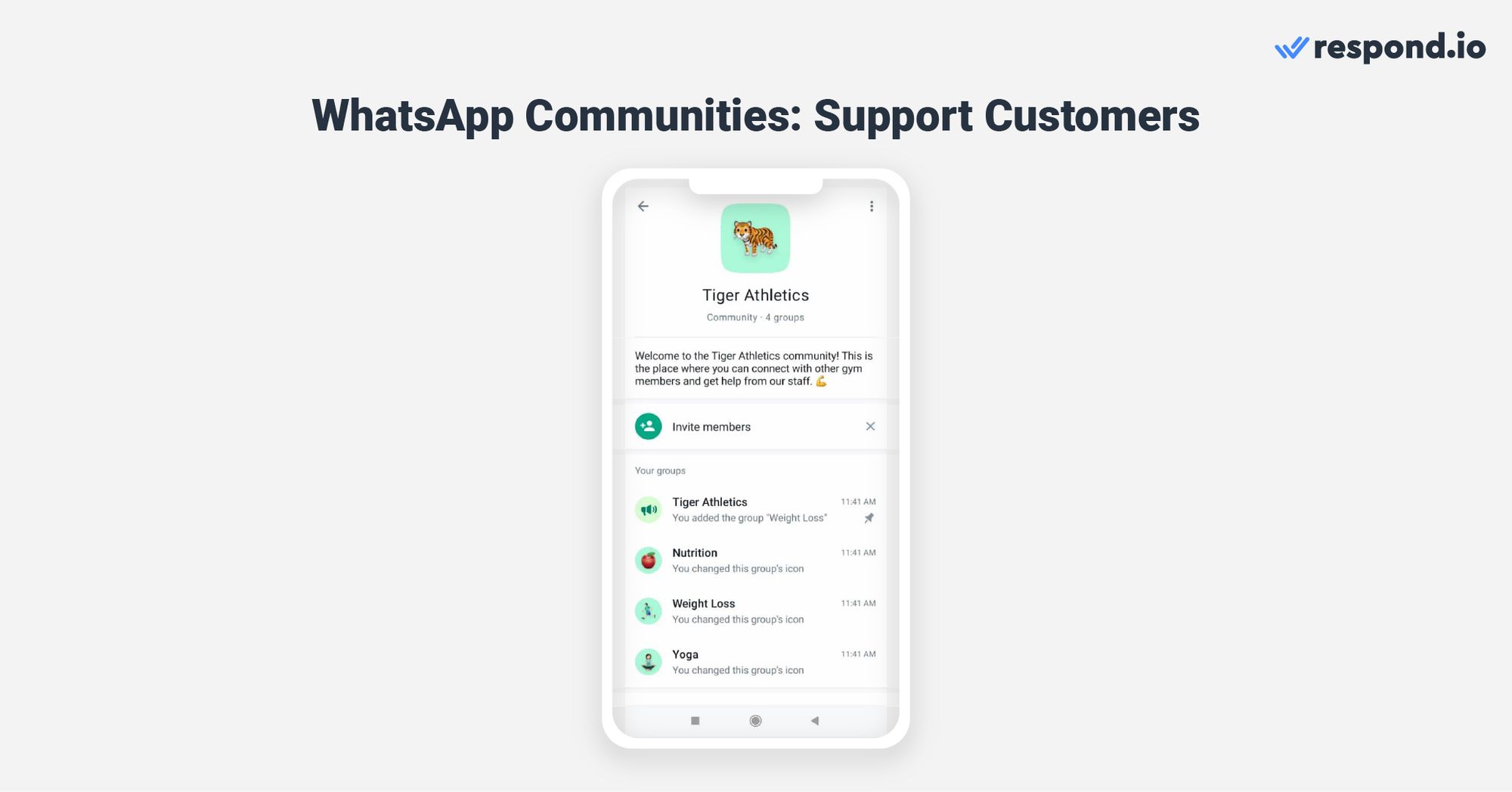
Além disso, administradores de grandes comunidades podem criar vários grupos com diferentes escopos de interesse. Por exemplo, uma academia local poderia educar os clientes em diferentes grupos chamados Nutrição, Perda de Peso e Ioga, entre outros.
Algumas empresas já usam o WhatsApp para comunicação interna. Enquanto empresas menores podem sobreviver com um grupo do WhatsApp, empresas maiores certamente podem usar um recurso como as Comunidades do WhatsApp para criar grupos para diferentes equipes.
Antes do lançamento das Comunidades, as empresas não tinham escolha a não ser manter todos os funcionários em um único grupo ou criar grupos separados para cada departamento. Eles tiveram que escolher entre um bate-papo desorganizado ou vários bate-papos desconexos.
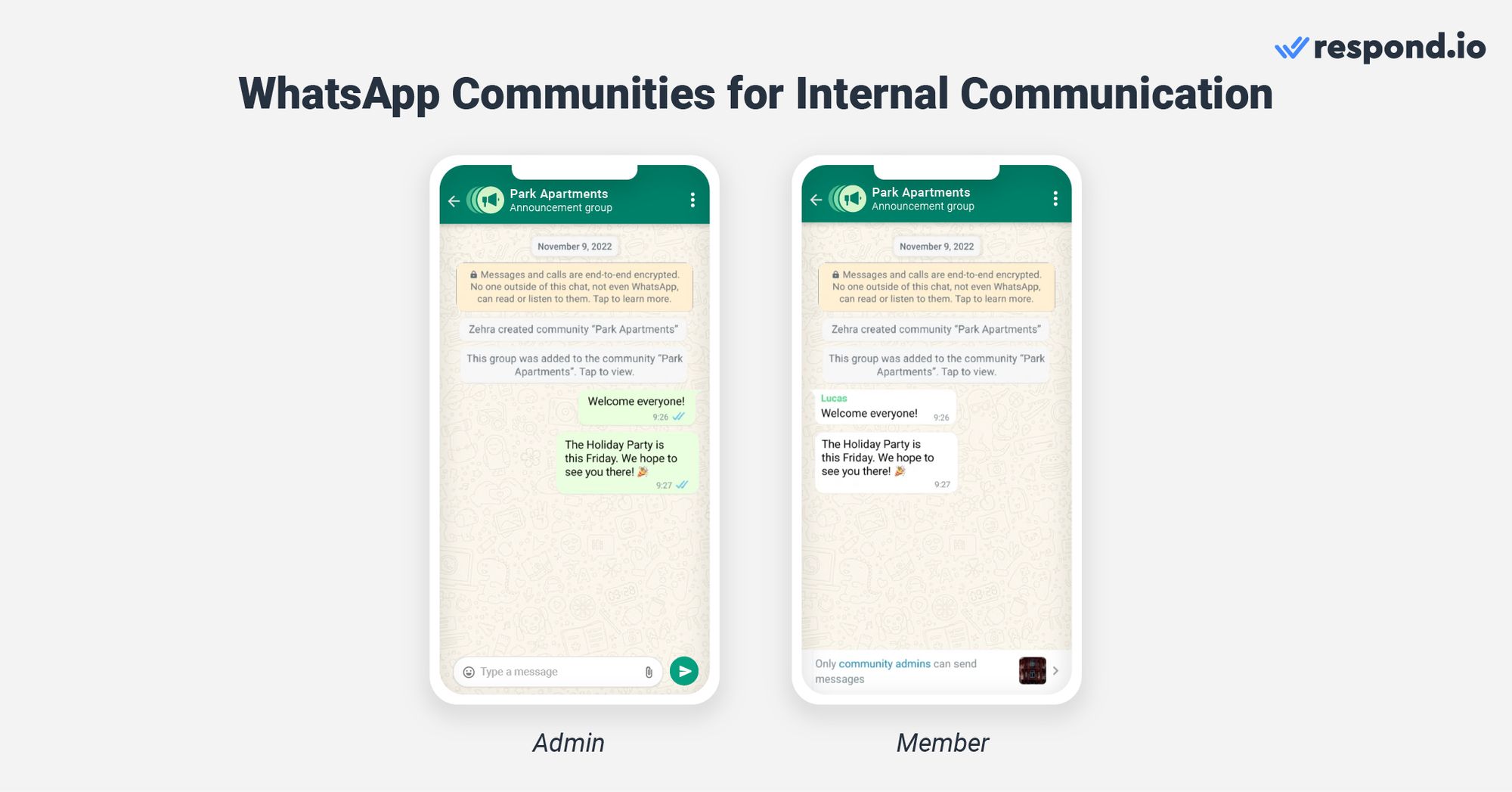
Agora, o grupo de anúncios é útil para obter informações importantes do diretor ou de recursos humanos da empresa.
Além disso, com as melhorias mencionadas anteriormente para chamadas de voz e arquivos de alto volume, o WhatsApp está um pouco mais perto de se tornar uma forte ferramenta de comunicação empresarial, como o Slack.
Para micro e pequenas empresas que usam o aplicativo pessoal WhatsApp, as Comunidades são uma boa maneira de conversar com clientes e transmitir mensagens aos membros do grupo de anúncios.
Embora as empresas que usam o WhatsApp Business App não possam acessar o recurso Comunidades, podem iniciar uma comunicação em massa enviando transmissões direcionadas para até 256 contatos do WhatsApp de cada vez. Além disso, os contatos não precisam se juntar a nenhum grupo para receber suas transmissões.
Se você é uma PME ou empresa com um grande público no WhatsApp, sua melhor escolha é obter uma conta da API do WhatsApp Business. Isso aumentará muito seus limites de transmissão e você poderá conectá-lo a uma caixa de entrada como o respond.io para obter recursos avançados adicionais, como resposta automática do WhatsApp, verificação de marca verde do WhatsApp e automação de bate-papo para marketing do WhatsApp, vendas ou suporte.
Depois de aumentar seus limites de transmissão, você pode esperar uma caixa de entrada cheia de respostas à sua transmissão. Para um gerenciamento eficaz de suas conversas multicanal e para garantir uniformidade nas informações compartilhadas, explore os recursos do respond.io's AI Agent.
Você precisa do WhatsApp paramensagens individuaisemensagens em massa? Experimente o respond.io gratuitamente e conecte sua conta da API do WhatsApp para começar.
Transforme conversas em clientes com a API oficial do WhatsApp da respond.io. ✨
Gerencie chamadas e chats do WhatsApp em um só lugar!
Você achou esta leitura interessante? Se sim, sugerimos que você dê uma olhada nos seguintes artigos.
Román Filgueira, formado pela Universidade de Vigo e Bacharel em Línguas Estrangeiras, juntou-se à equipe do respond.io como Redator de Conteúdo em 2021. Román oferece insights de especialistas sobre as melhores práticas para usar aplicativos de mensagens para impulsionar o crescimento dos negócios.

Saiba como atualizar para a API do WhatsApp sem perder chamadas de voz. Combine mensagens e voz para gerar confiança, resolver problemas complexos e se destacar.
